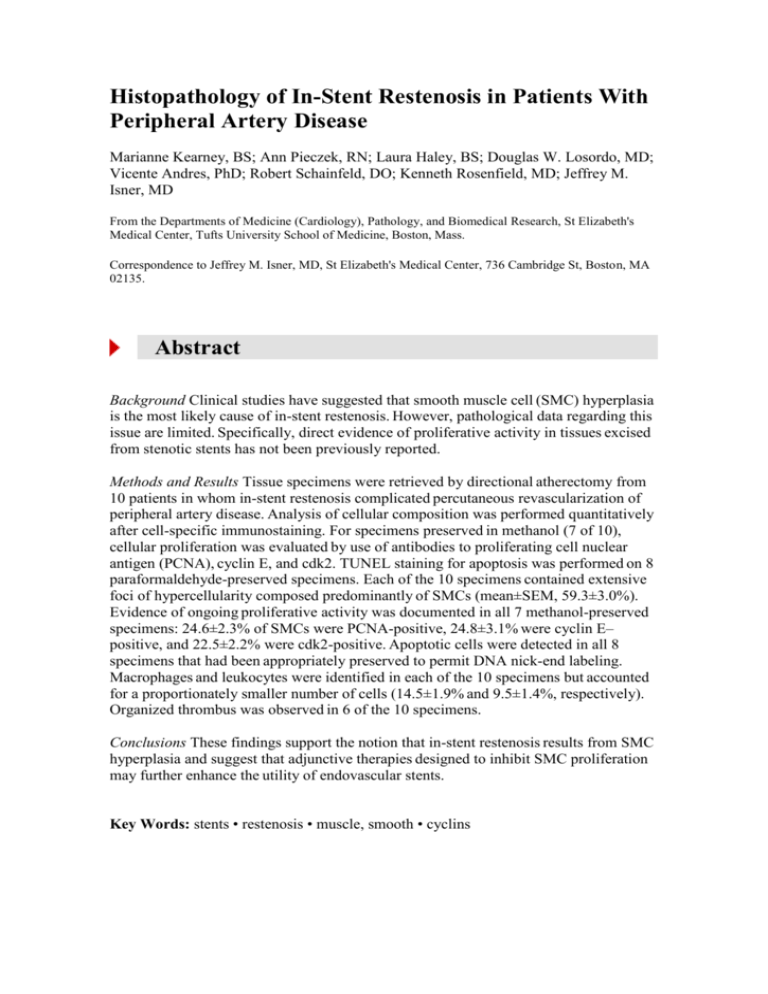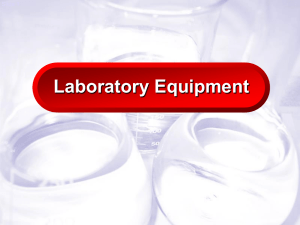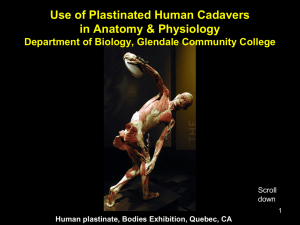Histopathology of In.
advertisement

Histopathology of In-Stent Restenosis in Patients With Peripheral Artery Disease Marianne Kearney, BS; Ann Pieczek, RN; Laura Haley, BS; Douglas W. Losordo, MD; Vicente Andres, PhD; Robert Schainfeld, DO; Kenneth Rosenfield, MD; Jeffrey M. Isner, MD From the Departments of Medicine (Cardiology), Pathology, and Biomedical Research, St Elizabeth's Medical Center, Tufts University School of Medicine, Boston, Mass. Correspondence to Jeffrey M. Isner, MD, St Elizabeth's Medical Center, 736 Cambridge St, Boston, MA 02135. Abstract Background Clinical studies have suggested that smooth muscle cell (SMC) hyperplasia is the most likely cause of in-stent restenosis. However, pathological data regarding this issue are limited. Specifically, direct evidence of proliferative activity in tissues excised from stenotic stents has not been previously reported. Methods and Results Tissue specimens were retrieved by directional atherectomy from 10 patients in whom in-stent restenosis complicated percutaneous revascularization of peripheral artery disease. Analysis of cellular composition was performed quantitatively after cell-specific immunostaining. For specimens preserved in methanol (7 of 10), cellular proliferation was evaluated by use of antibodies to proliferating cell nuclear antigen (PCNA), cyclin E, and cdk2. TUNEL staining for apoptosis was performed on 8 paraformaldehyde-preserved specimens. Each of the 10 specimens contained extensive foci of hypercellularity composed predominantly of SMCs (mean±SEM, 59.3±3.0%). Evidence of ongoing proliferative activity was documented in all 7 methanol-preserved specimens: 24.6±2.3% of SMCs were PCNA-positive, 24.8±3.1% were cyclin E– positive, and 22.5±2.2% were cdk2-positive. Apoptotic cells were detected in all 8 specimens that had been appropriately preserved to permit DNA nick-end labeling. Macrophages and leukocytes were identified in each of the 10 specimens but accounted for a proportionately smaller number of cells (14.5±1.9% and 9.5±1.4%, respectively). Organized thrombus was observed in 6 of the 10 specimens. Conclusions These findings support the notion that in-stent restenosis results from SMC hyperplasia and suggest that adjunctive therapies designed to inhibit SMC proliferation may further enhance the utility of endovascular stents. Key Words: stents • restenosis • muscle, smooth • cyclins Introduction Percutaneous delivery of balloon-expandable stents has been shown to reduce the frequency of restenosis.1 2 When restenosis does occur within a stent, such lesions have been considered to result from intimal proliferation.3 Published pathology data regarding this issue in humans, however, are limited.4 5 Specifically, direct evidence of proliferative activity in tissue retrieved from stenotic stents has not been reported previously. Because clinical experience has suggested that directional atherectomy for treatment of in-stent restenosis is unsuitable for coronary arteries,6 7 8 9 we studied a consecutive series of 10 specimens retrieved by directional atherectomy from patients with in-stent restenosis of noncoronary sites. Cell type–specific and cyclin-specific immunostains were used to identify evidence of cellular proliferation and thereby characterize the basis for in-stent restenosis. Methods Patients Clinical details regarding the patients from whom the specimens described in this report were retrieved are summarized in Table 1. Table 1. Clinical Findings in 10 Patients With In-Stent Restenosis Specimen Retrieval and Preparation All specimens were retrieved percutaneously by directional atherectomy.10 Tissues were fixed in either 10% buffered formalin (n=3) or 100% methanol (n=7). In addition, a portion of tissue from 8 patients was also preserved in 4% paraformaldehyde fixative to permit DNA nick-end labeling (see below). All tissues were embedded in paraffin, cut at 5-µm intervals, and stained with hematoxylin-eosin, elastic trichrome, and immunohistochemical stains for SMCs, macrophages, and leukocytes (see below). Immunostaining for PCNA, cyclin E, and cdk2 were used to establish evidence of proliferative activity among cellular elements in the atherectomy specimens.11 Because formalin fixation has previously been shown to attenuate the antigenicity of PCNA,11 12 13 we limited immunostaining for PCNA, cyclin E, and cdk2 to sections from those specimens that had been preserved in 100% methanol; sections of human tonsil12 were used as a positive control. Antibodies Immunohistochemical staining for proliferating cells was carried out with a mouse MAb against human PCNA (Signet) as well as two rabbit polyclonal antibodies against cyclin E and cdk2 (Santa Cruz). SMCs and macrophages were identified with an -actin alkaline phosphatase–conjugated MAb (Sigma) and HAM-56 MAb (Enzo), respectively. Leukocytes were identified with an MAb to CD-45 (Dako). Immunohistochemistry Immunoperoxidase staining was performed on serial sections.14 This involved blocking endogenous peroxidase with 3% hydrogen peroxide, preincubation in blocking serum, and applying the primary antibody at the appropriate dilution (PCNA, 1:40; cyclin E, 1:100; cdk2, 1:400; -actin, 1:300; HAM-56, undiluted; and CD-45, 1:50) overnight at 4°C. A biotinylated anti-mouse or anti-rabbit secondary antibody (Signet) was then applied for 30 minutes at room temperature, followed by a streptavidin–horseradish peroxidase complex. Sections were rinsed with PBS and visualized by incubation with either 0.05% (wt/vol) 3,3'-diaminobenzidine tetrahydrochloride dihydrate, 3-amino-9ethylcarbazole, or fast red substrate. A counterstain of 10% Gill's hematoxylin was applied before coverslipping. To detect apoptosis in situ, fragmented DNA was nick-end labeled with biotinylated dUTP introduced by terminal deoxytransferase and then stained with avidin-conjugated peroxidase.15 For each tissue, one section was processed as a positive control by pretreatment with DNase I, 1 µg/mL (Sigma), and one negative control was incubated in the absence of the terminal deoxytransferase enzyme. Light Microscopic Analysis Hematoxylin-eosin–stained sections were used to assess the presence of inflammatory cell infiltrates, calcific deposits, organized thrombus, foam cells, and cholesterol clefts. Elastic tissue–stained sections were used to assess the presence of media and adventitia. Quantitative analysis for each immunostain was performed by manually counting all cells in five randomly chosen high-power fields (x600); results of these quantitative analyses are reported as the percentage (mean±SEM) of positively stained cells among the five high-power fields. Results The quantitative results of pathological examinations performed on atherectomy specimens retrieved from sites of in-stent restenosis are summarized in Table 2 . Table 2. Pathological Findings in 10 Patients With In-Stent Restenosis Cellularity All 10 specimens contained extensive foci of hypercellularity (Fig 1 ). These foci were composed of -actin–positive cells with phenotypic characteristics of "activated" SMCs,12 including stellate morphology, surrounded by a loose, light-staining extracellular matrix. In all 10 specimens, -actin–positive cells represented the predominant cell type (mean±SEM, 59.3±3.0%). Figure 1. Representative hypercellular foci in tissue retrieved from sites of in-stent restenosis in each of 10 patients (Pt.). Low-power photomicrographs of -actin–immunostained sections show abundant cells with phenotypic characteristics of activated SMCs. In methanolpreserved specimens (Pts. 1, 4, 6, 7, 8, 9, and 10), View larger version (118K): immunostaining for PCNA disclosed evidence of abundant proliferative activity (insets). Evidence of ongoing proliferative activity was documented in all 7 specimens that were preserved in methanol fixative for immunostaining with antibodies to PCNA, cyclin E, and cdk2. Double immunostaining (Fig 2 ) indicated that most PCNA-, cyclin E–, and cdk2-positive cells were SMCs. Analysis of five randomly selected high-power (x600) fields from each of these 7 specimens indicated that 24.6±2.3% (16.7% to 36.0%) of the SMCs were PCNA-positive, 24.8±3.1% (14.0% to 40.5%) were cyclin E–positive, and 22.5±2.2% (12.8% to 30.0%) were cdk2-positive. Figure 2. Cell-specific, cell-cycle, and apoptotic immunostaining. Top, Proliferating SMCs doubleimmunostained for -actin and either PCNA, cyclin E, or cdk2. Bottom, Left and center, sparsely distributed macrophages (HAM56) and leukocytes (CD45). Bottom right, TUNEL staining. Arrows identify representative positive staining. View larger version (151K): Apoptosis Apoptotic cells were detected in all 8 specimens that had been appropriately preserved to permit DNA nick-end labeling (Fig 2 ). The extent of apoptotic cells (12.2±2.9%) was much greater than that described previously in atherectomy specimens retrieved from restenosis lesions.14 Macrophages and leukocytes were identified in all 10 specimens but accounted for a proportionately smaller number of cells (14.5±1.9% and 9.5±1.4%, respectively) (Fig 2 ). Foam cells were not observed in any specimen. Thrombus Thrombus was observed in 6 (60.0%) of 10 specimens; in all cases, thrombus was organized and integral to the excised tissue, as opposed to periprocedural collections of red blood cells. In all 10 cases, thrombus was limited to <5% of the area of the specimen. Other Findings Media was observed in one specimen retrieved from the superficial femoral artery; this portion of the specimen was excluded from further analysis. Adventitia was not observed in any specimen. Focal calcific deposits were limited to a single specimen. Discussion Because stents are considered to neutralize geometric effects, including remodeling,16 development of restenosis after stent implantation has been attributed principally to SMC proliferation. Successful application of intravascular radiation to limit thickening of stent neointima in a variety of animal models,17 18 19 on the premise that proliferating cells display enhanced sensitivity to ionizing radiation, constitutes indirect support for this notion. Likewise, accelerated endothelialization of stents after catheter delivery of the gene encoding vascular endothelial growth factor has been shown to markedly reduce SMC proliferation and thereby reduce luminal narrowing due to thickening of the stent neointima.20 Histological findings reported for a limited number of patients have suggested that instent restenosis is characterized by SMC hyperplasia. Pathological analysis of graft segments surgically retrieved from two patients described by Anderson et al5 revealed SMCs "with abundant eosinophilic cytoplasm and minimal interstitial tissue" in the tissue overlying the stent wires. Among four patients with in-stent restenosis described by van Beusekom et al,4 "... tissue that narrowed the vessels always consisted of SMCs (often with a `dendritic' appearance) within an extensive extracellular matrix." The extent of residual proliferative activity among these hypercellular foci was not specifically investigated in either series of patients. The findings in the present series of atherectomy specimens are consistent with the aforementioned histopathology studies. Each specimen contained extensive foci of hypercellularity, predominantly SMCs. Moreover, when these tissues were preserved in fixative specifically intended to preserve the antigenicity of PCNA, immunostaining performed with the corresponding monoclonal antibody disclosed that proliferative activity was abundant in all such specimens. Because one21 of three previous studies of native-vessel restenosis lesions21 22 23 was interpreted to show a paucity of SMC proliferation after immunostaining for PCNA, we used polyclonal antibodies to two additional cell cycle–regulatory proteins (cyclin 2 and cdk2) to confirm the extent of SMC proliferation observed for in-stent restenosis. Double immunostaining for all three cell cycle proteins and -actin confirmed that SMCs accounted for most of the proliferative activity. The findings in this study constitute the first direct evidence that SMC proliferation contributes to in-stent restenosis in human subjects and implies a potential role for adjunctive therapies intended to reduce in-stent restenosis by inhibiting SMC proliferation. The extent of cellular proliferation and apoptosis in the present series of in-stent restenosis specimens exceeds that observed in restenosis specimens retrieved from native vessels.11 14 Cardiovascular and noncardiovascular studies have typically disclosed a relationship between cellular proliferation and apoptosis,24 a concept that is consistent with the extensive proliferative activity demonstrated in the present series of specimens. The basis for this relationship between proliferative activity and programmed cell death remains to be established, but as suggested previously,14 25 26 apoptosis may act to limit the extent of cellular accumulation. Inflammatory cells, including foreign body granulomata formation, have been described in at least one previous animal study.27 Although neither giant cells nor granulomata were observed in the present series of specimens, occasional inflammatory cells were identified by CD-45 immunostaining. A relatively small HAM-56 macrophage population was identified as well, but the contribution of both cell types to restenosis in these 10 cases appears to be limited. The role of thrombus in restenosis, including in-stent restenosis, is enigmatic. Schwartz et al28 suggested that mural thrombus may constitute the primordial infrastructure that is subsequently colonized by activated SMCs. Thrombus was in fact observed in 6 of 10 specimens (60.0%) in the present cohort and thus cannot be excluded as a factor contributing to the genesis of peripheral vascular in-stent restenosis. The limited number of specimens (10) in the present series may be viewed as a limitation of this study. It should be noted, however, that the opportunity to study a larger number of specimens, particularly coronary specimens, has to date been limited by technical concerns regarding the use of directional atherectomy within stents.6 7 8 9 At least two cases7 8 of target-stent disruption secondary to (coronary) atherectomy have been reported previously, one of which required urgent bypass surgery. Although animal models have failed to disclose evidence of site-specific variation in the histopathology of in-stent neointimal thickening,4 29 it must be acknowledged that the extent to which the pathological features of in-stent restenosis described here in the lower-extremity vasculature can be extrapolated to other vascular beds, as well as other types of stents, awaits further confirmation. Selected Abbreviations and Acronyms MAb = monoclonal antibody PCNA = proliferating cell nuclear antigen SMCs = smooth muscle cells Acknowledgments This study was supported in part by an Academic Award in Vascular Medicine (HL02824) and grants HL-53354 and HL-57516 from the National Institutes of Health, Bethesda, Md. Received January 22, 1997; revision received February 25, 1997; accepted February 28, 1997. References 1. Fischman DL, Leon MB, Baim DS, Schatz RA, Savage MP, Penn I, Detre K, Veltri L, Ricci D, Nobuyoshi M, Cleman M, Heuser R, Almond D, Teirstein PS, Fish RD, Colombo A, Brinker J, Moses J, Shaknovich A, Hirshfeld J, Bailey S, Ellis S, Rake R, Goldberg S. A randomized comparison of coronary-stent-placement and balloon angioplasty in the treatment of coronary artery disease. N Engl J Med. 1994;331:496501.[Medline] [Order article via Infotrieve] 2. Serruys PW, DeJaegere P, Kiemeneij F, Macaya C, Rutsch W, Heyndrickx G, Emanuelsson H, Marco J, Legrand V, Materne P, Belardi J, Sigwart U, Colombo A, Goy JJ, Van Den Heuvel P, Delcan J, Morel M-A. A comparison of balloonexpandable-stent implantation with balloon angioplasty with coronary artery disease. N Engl J Med. 1994;331:489-495.[Medline] [Order article via Infotrieve] 3. Dussaillant GR, Mintz GS, Pichard AD, Kent KM, Satler LF, Popma JJ, Wong SC, Leon MB. Small stent size and intimal hyperplasia contribute to restenosis: a volumetric intravascular ultrasound analysis. J Am Coll Cardiol. 1995;26:720-724.[Abstract] 4. van Beusekom HMM, van der Giessen WJ, van Suylen RJ, Bos E, Bosman FT, Serruys PW. Histology after stenting of human vein bypass grafts: observations from surgically excised grafts 3 to 320 days after stent implantation. J Am Coll Cardiol. 1993;21:45-54.[Abstract] 5. Anderson PG, Bajaj RK, Baxley WA, Roubin GS. Vascular pathology of balloonexpandable flexible coil stents in humans. J Am Coll Cardiol. 1992;19:372381.[Abstract] 6. Topaz O, Vetrovec GW. The stenotic stent: mechanisms and revascularization options. Cathet Cardiovasc Diagn. 1996;37:293-299.[Medline] [Order article via Infotrieve] 7. Mecander PJ, Roubin GS, Agrawal SK, Cannon AD, Dean LS, Baxley WA. Balloon angioplasty for treatment of in-stent restenosis: feasibility, safety and efficacy. Cathet Cardiovasc Diagn. 1994;32:125-131.[Medline] [Order article via Infotrieve] 8. Bowerman RE, Pinkerton CA, Kirk B, Waller BF. Disruption of a coronary stent during atherectomy for restenosis. Cathet Cardiovasc Diagn. 1993;71:364-366. 9. Satler LF. Remedies for in-stent restenosis. Cathet Cardiovasc Diagn. 1996;37:320321.[Medline] [Order article via Infotrieve] 10. Simpson JB, Salmon MR, Robetson GC, Cipriano PR, Hayden WG, Johnson DE, Fogarty TJ. Transluminal atherectomy for occlusive peripheral vascular disease. Am J Cardiol. 1988;61:96G-101G.[Medline] [Order article via Infotrieve] 11. Pickering JG, Weir L, Jekanowski J, Kearney MA, Isner JM. Proliferative activity in peripheral and coronary atherosclerotic plaque among patients undergoing percutaneous revascularization. J Clin Invest. 1993;91:1469-1480. 12. Isner JM, Kearney M, Bauters C, Leclerc G, Nikol S, Pickering JG, Riessen R, Weir L. Use of human tissue specimens obtained in vivo by directional atherectomy to study restenosis and related human vascular disorders. Trends Cardiovasc Med. 1994;4:213221.[Medline] [Order article via Infotrieve] 13. Gelb AB, Kamel OW, LeBrun DP, Warnke RA. Estimation of tumor growth fractions in archival formalin-fixed, paraffin-embedded tissues using two antiPCNA/cyclin monoclonal antibodies. Am J Pathol. 1992;141:1453-1458.[Abstract] 14. Isner JM, Kearney M, Bortman S, Passeri J. Apoptosis in human atherosclerosis and restenosis. Circulation. 1995;91:2703-2711.[Abstract/Free Full Text] 15. Gavrieli Y, Sherman Y, Ben-Sasson SA. Identification of programmed cell death in situ via specific labeling of nuclear DNA fragmentation. J Cell Biol. 1992;119:493501.[Abstract/Free Full Text] 16. Isner JM. Vascular remodeling: Honey, I think I shrunk the artery. Circulation. 1994;89:2937-2941.[Free Full Text] 17. Hehrlein C, Gollan C, Donges BS, Metz J, Riessen R, Fehsenfeld P, von Hodenberg E, Kubler W. Low-dose radioactive endovascular stents prevent smooth muscle cell proliferation and neointimal hyperplasia in rabbits. Circulation. 1995;92:15701575.[Abstract/Free Full Text] 18. Waksman R, Robinson KA, Crocker IR, Gravanis MB, Palmer SJ, Wang C, Cipolla GD, King SB III. Intracoronary radiation before stent implantation inhibits neointima formation in stented porcine coronary arteries. Circulation. 1995;92:13831386.[Abstract/Free Full Text] 19. Laird JR, Carter AJ, Kufs WA, Hoopes TG, Farb A, Nott SH, Fischell RE, Fischell DR, Virmani R, Fischell TA. Inhibition of neointimal proliferation with low-dose irradiation from a ß-particle-emitting stent. Circulation. 1996;93:529536.[Abstract/Free Full Text] 20. Asahara T, Chen D, Kearney M, Rossow S, Passeri J, Symes JF, Isner JM. Accelerated re-endothelialization and reduced neointimal thickening following catheter transfer of phVEGF165. J Am Coll Cardiol. 1996;27:1A. Abstract. 21. O'Brien ER, Alpers CE, Stewart DK, Ferguson M, Tran N, Gordon D, Benditt EP, Hinohara T, Simpson JB, Schwartz SM. Proliferation in primary and restenotic coronary atherectomy tissue: implications for antiproliferative therapy. Circ Res. 1993;3:223-231. 22. Pickering JG, Bacha P, Weir L, Jekanowski J, Nichols JC, Isner JM. Prevention of smooth muscle cell outgrowth from human atherosclerotic plaque by a recombinant fusion protein specific for epidermal growth factor receptor. J Clin Invest. 1993;91:724729. 23. Rekhter M, Ferguson SN, Gordon D. Cell proliferation in human arteriovenous fistulas used for hemodialysis. Arterioscler Thromb. 1993;13:609617.[Abstract/Free Full Text] 24. Kerr JFR, Winterford CM, Harmon BV. Apoptosis: its significance in cancer and cancer therapy. Cancer. 1994;73:2013-2026.[Medline] [Order article via Infotrieve] 25. Bennett MR, Evan GI, Schwartz SM. Apoptosis of human vascular smooth muscle cells derived from normal vessels and coronary atherosclerosis plaques. J Clin Invest. 1995;95:2226-2274. 26. Geng Y-J, Libby P. Evidence for apoptosis in advanced human atheroma. Am J Pathol. 1995;147:251-266.[Abstract] 27. Karas SP, Gravanis MB, Santoian EC, Robinson KA, Anderberg KA, King SB III. Coronary intimal proliferation after balloon injury and stenting in swine: an animal model of restenosis. J Am Coll Cardiol. 1992;20:467-474.[Abstract] 28. Schwartz RS, Holmes DR Jr, Topol EJ. The restenosis paradigm revisited: an alternative proposal for cellular mechanisms. J Am Coll Cardiol. 1992;20:12841293.[Abstract] 29. Carter AJ, Laird JR, Farb A, Kufs W, Wortham DC, Virmani R. Morphologic characteristics of lesion formation and time course of smooth muscle cell proliferation in a porcine proliferative restonis model. J Am Coll Cardiol. 1994;24:13981405.[Abstract]






